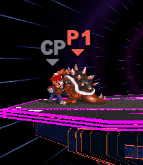| Welcome to SmashWiki! Log in or create an account and join the community, and don't forget to read this first! |
| Notices |
|---|
| The Skill parameter has been removed from Smasher infoboxes, and in its place are the new "Best historical ranking" and "Best tournament result" parameters. SmashWiki needs help adding these new parameters to Smasher infoboxes, refer to the guidelines here for what should be included in these new parameters. |
| When adding results to Smasher pages, include each tournament's entrant number in addition to the player's placement, and use the {{Trn}} template with the matching game specified. Please also fix old results on Smasher pages that do not abide to this standard. Refer to our Smasher article guidelines to see how results tables should be formatted. |
| Check out our project page for ongoing projects that SmashWiki needs help with. |
Multi-hit throw
A multi-hit throw is a throw that does damage in multiple parts. Typically, this is accomplished with a hitbox that strikes the grabbed opponent before they are released. An obvious example is Bowser's up throw, where the opponent is slashed multiple times with Bowser's shell before they are actually thrown. Multi-hit throws typically result in a throw dealing less knockback for the same amount of damage (due to how the knockback formula operates), but have the advantage of still slightly damaging the opponent even if the user is interrupted by something else. Several multi-hit throws cannot be distinguished as being multi-hit without reducing the game speed, as their hitbox strikes a frame or two before the throw occurs, such as Captain Falcon's forward, back, and up throws in Melee.
As the first hits of a multi-hit throw are generally regular hitboxes, they are capable of hitting bystanders. Some throws are partially designed for this purpose; Bowser's down throw does all of its damage with a hitbox and none with the throw itself, meaning both the grabbed opponent and any bystanders take the same damage.
Certain special moves can be considered multi-hit throws, an example being Dark Dive. On the other hand, moves such as Chomp or Koopa Klaw are not, instead acting as throws with pummels.
Multi-hit throws whose animation speed is based on the opponent's weight run the risk of rounding causing one-frame hitboxes to appear and disappear without the game checking to see if anyone has been hit. As a result, some throws don't deal as much damage as they should on opponents of a specific weight. Examples include Bowser's down throw in NTSC Melee and Link's down throw in Brawl, the former of which misses its first hit when throwing Jigglypuff or Mr. Game & Watch, and the latter of which misses its first hit when throwing Jigglypuff.


